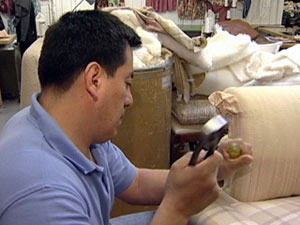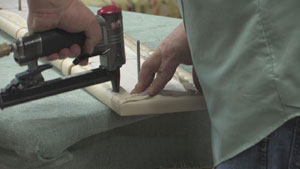Upholsterer
Tasks & duties

Upholsterers may do some or all of the following:
-
discuss requirements with customers
-
remove old covers from item to be recovered or repaired
-
remove and repair damaged or worn parts
-
calculate the amount of material required
-
draw up patterns or cutting plans
-
order material or parts from suppliers
-
remove parts that need replacing or repairing
-
cut materials to the right size and shape
-
sew the pieces together
-
attach springs, padding and covers to the furniture frames
-
fit carpet, linings and trims to the inside of vehicles
-
replace or repair vinyl/canvas-covered convertible car roofs
-
check the quality of finished work
Specialisations
Antique Furniture Upholster
Antique furniture upholsterers re-upholster antique furniture.
Vehicle Upholsterer
Vehicle upholsterers re-upholster seats in vehicles such as cars, boats or trucks.
Skills & knowledge

Upholsterers need to have:
-
knowledge of upholstery methods and materials
-
knowledge of furniture styles or vehicles, depending on their area of specialisation
-
knowledge of fabrics, threads, and colours
-
sewing and pattern-making skills
-
problem-solving skills
-
organisational skills
-
basic maths skills
Entry requirements
To become a furniture upholsterer you need to complete an apprenticeship and gain a National Certificate in Upholstery.
FITEC Furniture - for further training information
To become a vehicle upholsterer you need to complete an apprenticeship and gain a National Certificate in Motor Trimming.
New Zealand Motor Industry Training Organisation (MITO) - for further training information
Upholstery and motor trimming apprenticeships are part of the Modern Apprenticeship scheme, which is for people aged 16 to 21.
Modern Apprenticeships website - for further training information
Secondary education
There are no specific secondary education requirements, but three years of secondary education in English, maths, technical drawing, clothing and/or textiles is preferred.
Training on the job
Skills are gained on the job, as upholsterers need to keep up to date with new materials, threads, equipment and techniques.
Useful experience
Useful experience for upholsterers includes:
-
work in the furniture industry
-
experience working on motor vehicles
-
sales work
-
factory work
-
sewing or work with leather or fabric
Related courses
Fashion Design
Furniture Upholstery and Renovation
Upholstery and Vehicle Trimming
For more information, please refer to Career Services.
Sponsors include
Document Actions
